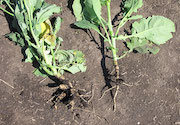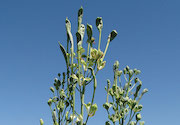| |
| |
 |
 |
| |
 |
|
@{mv_date_MMM d, yyyy}@ |
|
| |
 Snow, rain, drought, wind, hail – you name it, and the Prairies have seen it this year. Highlights from the latest crop reports reveal that some crops will be left in the field to overwinter.
» Read more...
Snow, rain, drought, wind, hail – you name it, and the Prairies have seen it this year. Highlights from the latest crop reports reveal that some crops will be left in the field to overwinter.
» Read more...
The Canadian Oilseed Processors Association is urging the federal government to take action to resolve the Canadian National Railway strike, which is currently causing delays in executing customer contracts.
» Read more...
A strike by CN rail workers will effectively halt the shipping of grain for many of Canada's canola farmers and negatively impact the industry's ability to supply international customers.
» Read more...
|
| |
 |
 |
| |
| INPUTS – THE PODCAST BY TOP CROP MANAGER |
|
|
| |

This bonus episode of Inputs is all about canola – from how harvest was to producer plans for 2020. Associate editor Stephanie Gordon shares highlights from when she travelled to Winnipeg to attend the Canola Discovery Forum from Nov. 13 to 15, 2019. In the episode, Keith Gabert, agronomy specialist with the Canola Council of Canada, shares ways growers can improve their integrated pest management strategies, producers Scott Keller and Troy LaForge share what they do on their operation, and Ashley Robinson, Canadian agriculture reporter with Bloomberg, shares the latest news on the China-Canada canola trade dispute.
» Listen here |
| |
|
| |
 Much can be learned from all the clubroot research conducted in Alberta in the last 15 years, and there are several management options that can help keep small patches of clubroot small. These include: knowing where to scout for clubroot, reducing soil compaction, marking out the area, increasing soil pH, and using a grass cover crop for the patch, among others.
» Learn more
Much can be learned from all the clubroot research conducted in Alberta in the last 15 years, and there are several management options that can help keep small patches of clubroot small. These include: knowing where to scout for clubroot, reducing soil compaction, marking out the area, increasing soil pH, and using a grass cover crop for the patch, among others.
» Learn more |
| |
 When you hear “aster yellows,” your mind may instantly flash back to 2012, when 77 per cent of the canola fields in Saskatchewan showed symptoms of the disease, and yield loss was estimated at eight per cent. But what if there was a way to get a head’s up on this disease? A team of scientists is working to develop a prediction tool by creating the very first Rapid Aster Yellows (RAY) warning system for Western Canada.
» Learn more
When you hear “aster yellows,” your mind may instantly flash back to 2012, when 77 per cent of the canola fields in Saskatchewan showed symptoms of the disease, and yield loss was estimated at eight per cent. But what if there was a way to get a head’s up on this disease? A team of scientists is working to develop a prediction tool by creating the very first Rapid Aster Yellows (RAY) warning system for Western Canada.
» Learn more |
| |
|
| |

|
| |
| |









